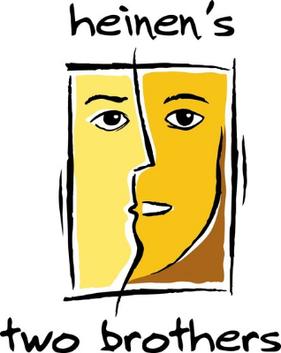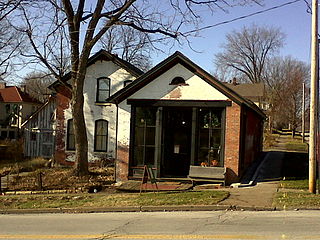
The Kroger Company, or simply Kroger, is an American retail company that operates supermarkets and multi-department stores throughout the United States.

German Village is a historic neighborhood in Columbus, Ohio, just south of the city's downtown. It was settled in the early-to-mid-19th century by a large number of German immigrants, who at one time comprised as much as a third of the city's entire population. It became a city historic district in 1960 and was added to the National Register of Historic Places in 1974, becoming the list's largest privately funded preservation district, and in 2007, was made a Preserve America Community by the federal government. In 1980, its boundaries increased, and today it is one of the world's premier historic restorations.

Meijer Inc. is an American supercenter chain that primarily operates throughout the Midwestern United States. Its corporate headquarters are in Walker, Michigan. Founded in 1934 as a supermarket chain, Meijer is credited with pioneering the modern supercenter concept in 1962. About half of the company's 259 stores are located in Michigan; the others are in Illinois, Indiana, Kentucky, Ohio and Wisconsin. The chain is ranked by Forbes as the 14th-largest private company in the United States, and is the country's 23rd-largest retailer by revenue as of 2023.

Giant Eagle, Inc. is an American supermarket chain with stores in Pennsylvania, Ohio, West Virginia, Indiana, and Maryland. The company was founded in 1918 in Pittsburgh, Pennsylvania, and incorporated on August 31, 1931. Supermarket News ranked Giant Eagle 21st on the "Top 75 North American Food Retailers" based on sales of $11 billion. In 2021, it was the 36th-largest privately held company, as determined by Forbes. Based on 2005 revenue, Giant Eagle is the 49th-largest retailer in the United States. As of summer 2014, the company had approximately $9.9 billion in annual sales. As of fall 2023, Giant Eagle, Inc. had 496 stores across the portfolio: 211 supermarkets 8 standalone pharmacies, 274 fuel station/convenience stores under the GetGo banner, and three standalone car wash under the WetGo banner. The company is headquartered in an office park in Cranberry Township, PA in Butler County.
Fred Meyer, Inc. is an American chain of hypermarket superstores and subsidiary of Kroger based in Portland, Oregon. The stores operate in the northwestern United States, with locations in Oregon, Washington, Idaho, and Alaska. The company was founded in 1922 by Fred G. Meyer in Portland. The chain was one of the first in the country to promote one-stop shopping, eventually combining a complete grocery supermarket with a drugstore, bank, clothing, jewelry, home decor, home improvement, garden, electronics, restaurant, shoes, sporting goods, and toys. Fred Meyer was acquired by Kroger in 1998, but the stores retained the Fred Meyer name.

The LeVeque Tower is a 47-story skyscraper in Downtown Columbus, Ohio. At 555 feet 5 inches (169.29 m) it was the tallest building in the city from its completion in 1927 to 1974, and remains the second-tallest today.

Heinen's is an American family-owned and operated regional supermarket chain that was founded in 1929. The chain has locations in Northeast Ohio and in the Chicago metropolitan area. It was founded by Joe Heinen, a butcher, who opened the first store near his butcher shop. The company now operates under the leadership of his grandsons Jeff and Tom Heinen and their children, Kim, Kelsey, and Jake Heinen.

Westland Mall is a demolished 860,000-square-foot (80,000 m2) shopping center located at the intersection of U.S. Route 40 and Interstate 270 on the west side of Columbus, Ohio. In November 2012, the majority of the mall closed, and the last anchor closed in 2017. A mixed use development is planned, and demolition began around August 2023.

Downtown Columbus is the central business district of Columbus, Ohio. Downtown is centered on the intersection of Broad and High Streets, and encompasses all of the area inside the Inner Belt. Downtown is home to most of the tallest buildings in Columbus.

The Main Street Historic District in Tampico, Illinois, United States, is a historic district notable as home to the birthplace of Ronald Reagan. The district includes the late 19th century collection of buildings that comprise Tampico's central business district; among them are two apartments that the Reagan family occupied in the early 1900s. The buildings in the district went through several periods of rebuilding during the 1870s due to major fires and a tornado. The district boundaries encompass the 100 block of Main Street and exclude properties that do not date from the historic period.

The Main Street Historic District in Fort Atkinson, Wisconsin, United States, was placed on the National Register of Historic Places in 1984. The district is composed of 51 buildings on or within a block of Main Street.

Story is an unincorporated community in Van Buren Township, Brown County, in the U.S. state of Indiana.

The Christian Jipp Home & Grocery is a historic building located in the Hamburg Historic District in Davenport, Iowa, United States. The district was added to the National Register of Historic Places in 1983. The house and grocery was individually listed on the Davenport Register of Historic Properties in 2005.

Tiedtke's was a former grocery and department store chain based in Toledo, Ohio. At its peak, the store, which began life as a grocery, occupied a huge building at Summit Street and Adams downtown, maintained an annex store two blocks away, and a branch store in north Toledo. It was a unique Toledo experience, and a community center. The family-founded store changed hands several times before all locations closed by 1973. The original store building was destroyed by fire two years later.

The Ohio History Center is a history museum and research center in Columbus, Ohio. It is the primary museum for Ohio's history, and is the headquarters, offices, and library of the Ohio History Connection. The building also houses Ohio's state archives, also managed by the Ohio History Connection. The museum is located at the Ohio State Fairgrounds, site of the Ohio State Fair, and a short distance north of downtown. The history center opened in 1970 as the Ohio Historical Center, moving the museum from its former site by the Ohio State University. The building was designed by Ireland & Associates in the Brutalist style. It was listed on the National Register of Historic Places along with the Ohio Village in 2023.

The Toledo and Ohio Central Railroad Station, today named Station 67, is a union meeting space and event hall located in Franklinton, near Downtown Columbus, Ohio. Built by the Toledo and Ohio Central Railroad from 1895 to 1896, it served as a passenger station until 1930. It served as an office and shelter for Volunteers of America from 1931 to 2003, and has been the headquarters of International Association of Fire Fighters Local 67, a firefighters' union, since 2007. The building was placed on the National Register of Historic Places in 1973. During its history, the building has experienced fires and floods, though its relatively few owners have each made repairs and renovations to preserve the building's integrity. The building is the last remaining train station in Columbus.

Lucky's Market is a brand of supermarkets that are being used by two independent and unrelated regional supermarket chains, LM Acquisition Co. LLC in Colorado and Lucky's Market Ohio in Ohio.

The Simeon Mills Historic District is a group of seven historic commercial buildings two blocks west of the capitol square in Madison, Wisconsin, constructed from around 1845 to 1887. In 1987 the district was added to the National Register of Historic Places - considered significant for its concentration of 19th century commercial buildings, which is unique in Madison.

Gaetz Music House is a historic building in Downtown Columbus, Ohio. It was listed on the National Register of Historic Places in 2014.

171–191 South High Street is a pair of historic buildings in Downtown Columbus, Ohio. The commercial structures have seen a wide variety of retail and service uses through the 20th century, including shoe stores, groceries, opticians, hatters, jewelers, a liquor store, and a car dealership. Both exhibit early 20th century façades; 185–191 South High was constructed in 1906, while 171–177 South High was constructed sometime in the 19th century and was remodeled in the second decade of the 20th century. The latter building was once part of the Lazarus Block, holding the original Lazarus department store. The store grew to encompass a group of seven buildings on the site until it moved to the Lazarus Building in 1909. The same building was again noted in the 1930s, for housing the first Kroger store in Downtown Columbus, which was considered the first supermarket in the city. The buildings, the nearby Ohio National Bank building, and a garage building were sold to a development company in 2023. The developer plans to renovate the bank building and demolish all other structures on the block. In June 2023 the buildings were placed on the Columbus Landmarks Foundation's Most Endangered List.























